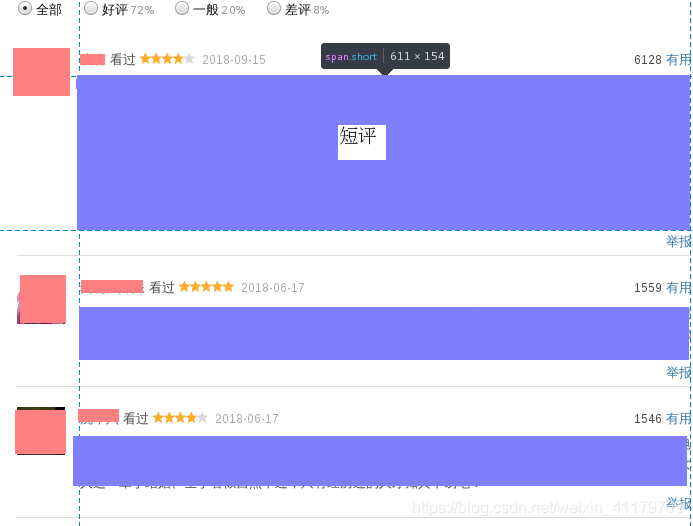詳解使用Python爬取豆瓣短評並繪製詞雲
阿新 • • 發佈:2018-12-04
使用Python爬取豆瓣短評並繪製詞雲
成果如下(比較醜,湊合看)

1.分析網頁
開啟想要爬取的電影,比如《找到你》,其短評如下:

檢視原始碼

發現短評存放在<span>標籤裡 並且class為short,所以通過爬取其裡邊的內容即可
並且通過翻頁發現:url改變的僅僅為start,每次翻頁增加20,所以只需for迴圈增加數字即可控制頁數



2.獲取其網頁內容
我們使用bs4以及requests模組進行獲取,並使用多執行緒加快爬取速度
import threading import requests from bs4 import BeautifulSoup # # 1). 爬取某一頁的評論資訊; def getOnePageComment(id, pageNum): # 1). 根據頁數確定start變數的值 # 第一頁: https://movie.douban.com/subject/26425063/comments?start=0&limit=20&sort=new_score&status=P # 第二頁: https://movie.douban.com/subject/26425063/comments?start=20&limit=20&sort=new_score&status=P # 第三頁: https://movie.douban.com/subject/26425063/comments?start=20&limit=40&sort=new_score&status=P start = (pageNum-1)*20 url = "https://movie.douban.com/subject/%s/comments?start=%s&limit=20&sort=new_score&status=P" %(id, start) # 2). 爬取評論資訊的網頁內容 content = requests.get(url).text # 3). 通過bs4分析網頁 soup = BeautifulSoup(content, 'lxml') # 分析網頁得知, 所有的評論資訊都是在span標籤, 並且class為short; commentsList = soup.find_all('span', class_='short') pageComments = "" # 依次遍歷每一個span標籤, 獲取標籤裡面的評論資訊, 並將所有的評論資訊儲存到pageComments變數中; for commentTag in commentsList: pageComments += commentTag.text # return pageComments print("%s page" %(pageNum)) global comments comments += pageComments # 2).爬取某個電影的前10頁評論資訊; id = '27140071' comments = '' threads = [] # 爬取前10頁的評論資訊;獲取前幾頁就迴圈幾次; for pageNum in range(10): # 0 , 1 2 3 4...9 pageNum = pageNum + 1 # getOnePageComment(id, pageNum) # 通過啟動多執行緒獲取每頁評論資訊 t = threading.Thread(target=getOnePageComment, args=(id, pageNum)) threads.append(t) t.start() # 等待所有的子執行緒執行結束, 再執行主執行緒內容; _ = [thread.join() for thread in threads] print("執行結束") with open("%s.txt" %(id), 'w') as f: f.write(comments)
成果如下


3.資料清洗
對於爬取的評論資訊進行資料清洗(刪除不必要的逗號, 句號, 表情, 只留下中文或者英文內容)
在此使用re模組使用正則表示式進行資料清洗
with open('找到你.txt','a+') as f: comments = f.read() print(comments) # 通過正則表示式實現 pattern = re.compile(r'([\u4e00-\u9fa5]+|[a-zA-Z]+)') deal_comments = re.findall(pattern, comments) newComments = '' print(newComments) for item in deal_comments: newComments += item print(newComments) f.write(newComments)
4.製作詞雲
通過jiaba(通過詞庫切割中文)、wordcloud(製作詞雲)模組實現
import jieba import wordcloud import numpy as np # 在python2中處理影象,Image; python3中如果處理影象, 千萬不要安裝Image, 安裝pillow from PIL import Image # 1). 切割中文, lcut返回一個列表, cut返回一個生成器; result = jieba.lcut(open('找到你.txt').read()) # 2). 開啟圖片 imageObj = Image.open('./doc/mao.jpg') cloud_mask = np.array(imageObj) # 4). 繪製詞雲 wc = wordcloud.WordCloud( mask = cloud_mask, background_color='black', font_path='./font/msyh.ttf', # 處理中文資料時 min_font_size=5, # 圖片中最小字型大小; max_font_size=50, # 圖片中最大字型大小; width=500, # 指定生成圖片的寬度 ) wc.generate(",".join(result)) wc.to_file('找到你.png')
(效果如圖,背景大家可以找點自己喜歡的)

